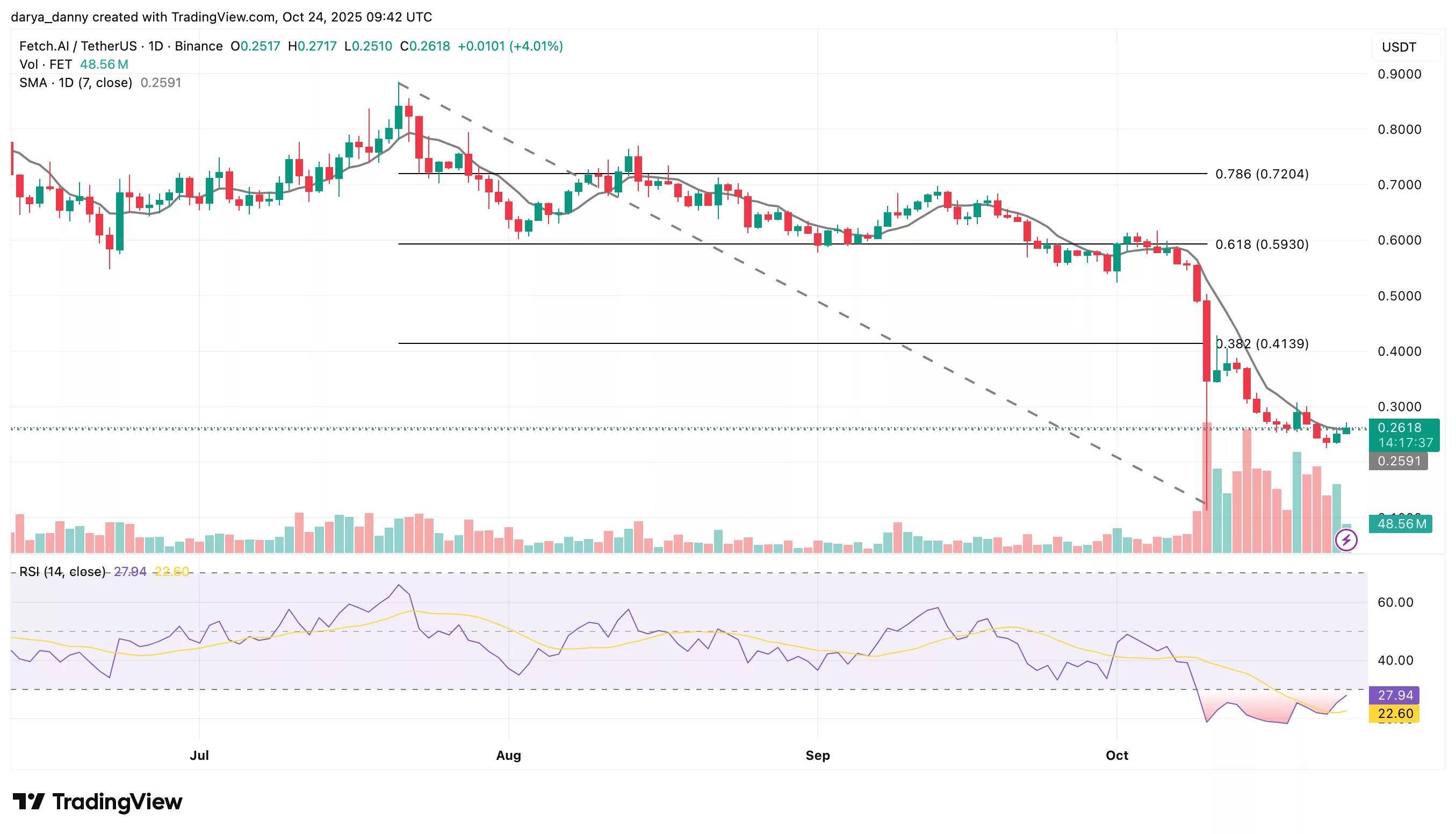
FET price may have bottomed at $0.23, showing signs of easing bearish pressure as the Ocean Protocol saga unfolds and Fetch.ai announces a weekly 50 FET burn per wallet registered on asi1.ai.
Summary
- FET price has bounced from a $0.23 bottom, with technicals (7-day SMA, RSI) suggesting bearish momentum may be easing.
- FET recent crash was driven by renewed U.S.–China trade tensions and the Ocean Protocol fallout.
- Fetch.ai CEO Humayun Sheikh plans to pursue class-action lawsuits across multiple jurisdictions over the disputed token transfers by Ocean Protocol.
- The Fetch Foundation announced weekly burns of 50 FET per wallet registered on asi1.ai.
Fetch.AI (FET) price appears to be in the early stages of a potential recovery after what looks like a bottom around the $0.23 level. The token has bounced from that zone, currently trading near $0.26.
Importantly, FET price is attempting to reclaim the 7-day SMA, a sign that short-term momentum is beginning to shift back in favor of buyers. The RSI is also showing the first signs of divergence: while FET price recently made a lower high, RSI formed equal highs. The indicator is now curling upward from deeply oversold territory near 27, suggesting that bearish momentum may be nearing exhaustion.
If FET price can sustain above the newly established support zone at $0.23 — ideally with decreasing selling volume — accumulation could gradually build, laying the groundwork for a potential recovery toward $0.40 (the 0.382 Fib level, which was broken on October 10 during the broader crypto market sell-off triggered by renewed trade tensions). A successful rebound above this level could pave the way for a further push toward $0.60, the previous consolidation base that gave way prior to the October 10 flash crash.
Looking ahead, a successful reclamation of $0.40, along with RSI recovery above 30 from deeply oversold territory, would serve as an early signal that a reversal may be underway.

Why did FET price crash?
FET crashed 30% on October 10 amid the broader crypto market bloodbath, which was triggered by escalating U.S.-China trade tensions. President Donald Trump’s announcement of a 100% tariff on Chinese tech exports and export controls on critical software led to a sharp market reaction. Bitcoin (BTC) dropped 8.4% to $104,782, and Ethereum (ETH) fell 5.8% to $3,637, with many altcoins suffering double-digit losses.
On October 9, just a day before the broader market crash, Ocean Protocol—a major partner in the Artificial Superintelligence Alliance—withdrew from the collaboration. Subsequent on-chain data revealed that a multisignature wallet associated with Ocean Protocol converted 661 million OCEAN tokens into 286 million FET tokens on July 1. Those tokens were then distributed, with approximately 270 million FET sent to exchanges such as Binance and GSR Markets. As a result, Humayun Sheikh—Fetch.ai’s CEO—announced plans to fund class-action lawsuits across three or more jurisdictions.
On October 21, Sheikh also offered a $250,000 bounty for information leading to the identification of the signatories behind Ocean Protocol’s multisig wallet, aiming to uncover the individuals responsible for converting and distributing the disputed 286 million FET tokens, valued at around $120 million, to exchanges without proper disclosure.
The bounty has now been concluded. According to Sheikh, all necessary information has been received from verified contributors, and the $250,000 reward will be distributed accordingly.
On October 23, Sheikh announced that for every Fetch wallet that creates an account on asi1.ai, the Fetch Foundation will burn 50 FET tokens. The burns and reconciliations are scheduled to occur weekly, aiming to restore value for FET holders.

Source link

